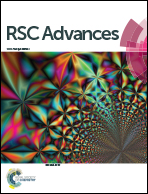Preferential binding of anticancer drugs to triplex DNA compared to duplex DNA: a spectroscopic and calorimetric study†
Abstract
Adriamycin and actinomycin are frequently used anti-cancer drugs for the treatment of a variety of human cancers. The resistance and side effects are the major drawbacks that have been attributed to their non-specific nature of binding to DNA. Therefore, one efficient strategy is to target drug-delivery to sequence/and structure specific DNA regions so that higher potency can be achieved. We have chosen a positive regulatory region (−183 to −165 from the transcription start site) in the hmgb1 gene as the sequence specific target and also made DNA triplex (of the same region) as a structure specific target for anti-cancer drugs. The conformational and binding characteristics were studied by UV-vis spectroscopy, circular dichroism, fluorescence spectroscopy, Fourier transform infrared spectroscopy and isothermal titration calorimetry. Binding results showed that in presence of the triplex forming oligonucleotide, the DNA triplex formed by the target DNA had higher binding affinity to the drugs as compared to the DNA duplex alone. The results suggest that an anti-gene approach of DNA triplex in combination with an anti-cancer drug be used as a preferential option in achieving higher efficacy. Furthermore, the DNA triplex structure-specific target can alleviate unwanted side effects from anti-cancer drugs.


 Please wait while we load your content...
Please wait while we load your content...